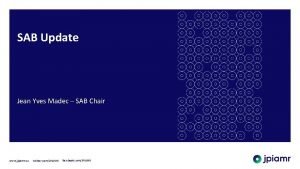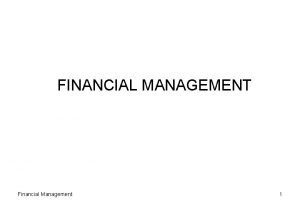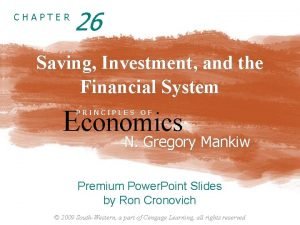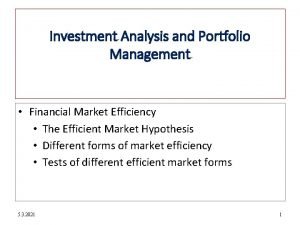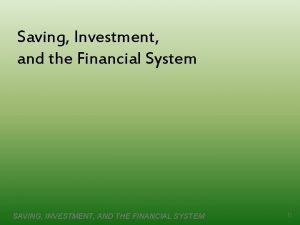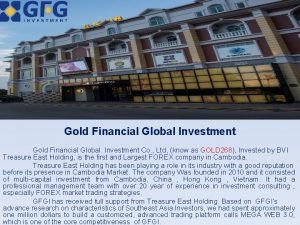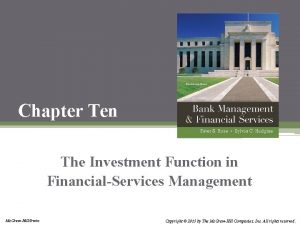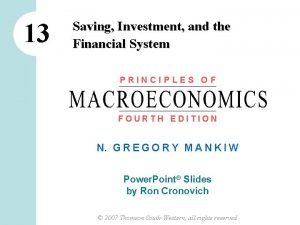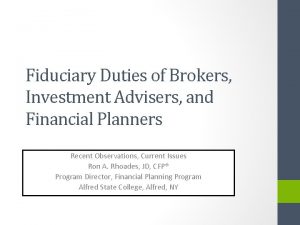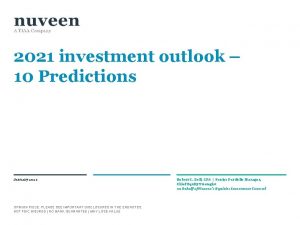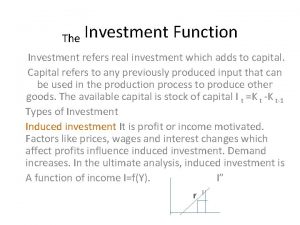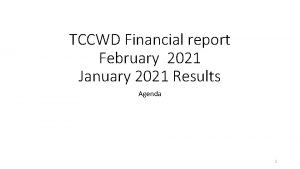Investment update for financial advisers January 2021 This





















































- Slides: 53

Investment update for financial advisers January 2021 This material is not for circulation to retail investors

Important information This information has been provided for the funds in the table below by MLC Investments Limited (ABN 30 002 641 661 AFSL 230705) as Responsible Entity for the MLC Investment Trust, NULIS Nominees (Australia) Limited (ABN 80 008 515 633, AFSL 236465) as trustee of the MLC Master. Key Fundamentals Super and Pension and MLC Master. Key Business Super products which are a part of the MLC Super Fund (ABN 70 732 426 024), and for the MLC Managed Account Strategies by MLC Asset Management Pty Ltd (ABN 44 106 427 472, AFSL 308953) in connection with its distribution of these MLC Managed Accounts Strategies, members of the National Australia Bank Limited (ABN 12 004 044 937, AFSL 230686) group of companies (NAB Group), 105– 153 Miller Street, North Sydney 2060. NAB does not guarantee or otherwise accept any liability in respect of any financial product referred to in this document or MLCAM’s services. This document has been prepared for financial advisers. This document must not be distributed to ‘retail clients’ (as defined in the Corporations Act 2001 (Cth)) or any other persons. This information is directed to and prepared for Australian residents only. This information may constitute general advice. It has been prepared without taking account of an investor’s objectives, financial situation or needs and because of that an investor should, before acting on the advice, consider the appropriateness of the advice having regard to their personal objectives, financial situation and needs. You should obtain a Product Disclosure Statement (PDS) relating to the financial products mentioned in this communication issued by MLC Investments Limited or NULIS Nominees (Australia) Limited as trustee of the MLC Super Fund (ABN 70 732 426 024), and consider it before making any decision about whether to acquire or continue to hold these products. A copy of the PDS is available upon request by phoning the MLC call centre on 132 652 or on our website at mlc. com. au. MLC Managed Accounts Strategies are available via investment platforms. Please refer to the MLC Asset Management website www. mlcam. com. au) for a full list of platform availability. Investors should obtain a Product Disclosure Statement relating to the investment platform and consider it before making any decision about whether to acquire or continue to hold interests in the Model Portfolios. Past performance is not a reliable indicator of future performance. The value of an investment may rise or fall with the changes in the market. Returns are not guaranteed and actual returns may vary from any target returns described in this document. No representations are made that they will be met. Please note that all performance reported is before management fees and taxes, unless otherwise stated. Any projection or other forward-looking statement (‘Projection’) in this communication is provided for information purposes only. No representation is made as to the accuracy or reasonableness of any such Projection or that it will be met. Actual events may vary materially. MLC Investment Limited, NULIS Nominees (Australia) Limited, and MLC Asset Management Pty Ltd may use the services of NAB Group companies where it makes good business sense to do so and will benefit customers. Amounts paid for these services are always negotiated on an arm’s length basis. Bloomberg Finance L. P. and its affiliates (collectively, “Bloomberg”) do not approve or endorse any information included in this material and disclaim all liability for any loss or damage of any kind arising out of the use of all or any part of this material. ) The funds referred to herein are not sponsored, endorsed, or promoted by MSCI, and MSCI bears no liability with respect to any such funds. MLC funds and Managed Account Strategies referenced in this communication are listed below. These funds appear on MLC’s platforms, in addition to a number of external platforms: MLC Investment Trust: MLC Super Fund: MLC Managed Account Strategies: MLC Wholesale Horizon 2 Income Portfolio MLC Horizon 2 Capital Stable Portfolio MLC Premium Moderate Model Portfolio MLC Wholesale Horizon 3 Conservative Growth Portfolio MLC Premium Assertive Model Portfolio MLC Wholesale Horizon 4 Balanced Portfolio MLC Premium Aggressive Model Portfolio MLC Wholesale Horizon 5 Growth Portfolio MLC Value Moderate Model Portfolio MLC Wholesale Horizon 6 Share Portfolio MLC Value Assertive Model Portfolio MLC Wholesale Horizon 7 Accelerated Growth Portfolio MLC Value Aggressive Model Portfolio MLC Wholesale Inflation Plus Conservative Portfolio MLC Inflation Plus Conservative Portfolio MLC Wholesale Inflation Plus Moderate Portfolio MLC Inflation Plus Moderate Portfolio MLC Wholesale Inflation Plus Assertive Portfolio MLC Inflation Plus Assertive Portfolio MLC Wholesale Index Plus Conservative Growth Portfolio MLC Index Plus Conservative Growth Portfolio MLC Wholesale Index Plus Balanced Portfolio MLC Index Plus Balanced Portfolio 2 MLC Wholesale Index Plus Growth Portfolio MLC Index Plus Growth Portfolio

Market update

Asset class returns for 2020 Investors have enjoyed generally positive (and strong) returns over short, medium and long periods 15% • Despite severe outbreaks of COVID-19 in the northern hemisphere, the rollout of several vaccines has buoyed sentiment towards riskier assets • Continued vaccination and growing innate immunity should begin to reverse the worsening pandemic situation over the course of the coming months • Markets seem to be erring on the optimistic side, with multiples paid for riskier assets, anticipating strong growth 10% 5% 0% -5% -10% -15% Australian. Global shares Global (hedged) shares Emerging (unhedged) markets Australian (unhedged) Global property securities Australian (hedged) Global bonds Australian (hedged) Inflation-linked bonds Cash 3 Months to Dec 2020 % 1 year to Dec 2020 % 5 years to Dec 2020 % p. a. 10 years to Dec 2020 % p. a. 3 years to Dec 2020 % p. a. AUD/USD Index data source: Australian shares - S&P/ASX 200 Accumulation Index ; Global shares (hedged) - MSCI All Countries World (A$ hedged) ; Global shares (unhedged) - MSCI All Countries World; Emerging markets - MSCI Emerging Markets ; Australian property securities - S&P/ASX 300 LPT Accumulation Index; Global property securities - FTSE EPRA/NAREIT Developed (A$ hedged); Australian bonds - Bloomberg Aus. Bond Composite 0+ Yr Index; Global bonds (A$ hedged) - BCGA Global Agg (A$ hedged); Australian inflation-linked bonds - Bloomberg Aus. Bond Inflation Government 0+ Yr Index; Cash - Bloomberg Aus. Bond Bank Bill Index; USD/AUD - WM/Reuters Daily Investment update for financial advisers 4

Sharp swings in global share markets in 2020 Most global share markets recorded positive returns for the year Mar qtr pain Jun qtr recovery Sep qtr mixed Dec qtr vaccine bounce Year to 31 Dec 2020 USA S&P 500 Index -19. 7% 20. 4% 8. 8% 12. 0% 17. 8% Australia S&P/ASX 300 Total Return Index -23. 4% 16. 8% -0. 1% 13. 7% 1. 4% UK FTSE 100 Index -23. 8% 9. 1% -4. 0% 10. 9% -11. 6% Germany DAX Index -25. 0% 23. 9% 3. 7% 7. 5% 3. 5% China MSCI China Index -10. 3% 15. 3% 12. 0% 10. 7% 28. 1% Source: Fact. Set. Measured in local currency terms. Investment update for financial advisers 5

Value outperformed briefly after a long period of underperformance But too early to know if it’s a turning point Value vs Growth/Momentum annual returns 8. 0% Value Growth/Momentum 6. 0% 4. 0% 2. 0% 0. 0% -2. 0% -4. 0% -6. 0% 16 20 17 20 18 20 19 20 Q 20 4 20 20 20 15 20 14 20 13 20 12 20 11 20 10 20 09 20 08 20 07 20 06 20 05 20 04 20 03 20 02 20 01 20 00 20 99 19 98 19 97 19 96 19 19 95 -8. 0% Source: Barra and MLC Asset Management Services Limited, updated to 31 December 2020. The returns shown are based on long-short portfolios and represent returns of more ‘pure’ style factors rather than returns of managers with a particular style bias. Investment update for financial advisers 6

Foreign currency has been a great diversifier in 2020 AUD: USD $0. 80 • Historically the AUD and global share markets tend to move in the same direction. Not hedging some overseas assets can help insulate the portfolio from losses if share markets fall • This buffering of returns worked well for our portfolios during the COVID crash in March 2020 when share markets and the AUD fell sharply • After the sell off we slightly increased AUD hedging, which was another profitable decision for portfolios in second half of 2020 as AUD rose $0. 75 $0. 70 $0. 65 $0. 60 02 0 -2 ec D N ov -2 20 -2 0 O ct 02 0 p 2 Se 02 0 Au g 2 0 l-2 02 Ju 20 20 n. Ju 02 0 ay M -2 Ap r -2 02 0 0 M ar -2 02 0 20 2 b- Fe Ja n- 20 20 $0. 55 Source: Reserve Bank of Australia Investment update for financial advisers 7

Economies are recovering after horrendous mid year falls Global GDP change in June quarter 2020 17 20 Global GDP change in Sept quarter 2020 Global Economic Activity 8 8 Real GDP annual % change 15 15 13 10 6 6 4 4 2 2 11 5 9 Australia 0 7 0 -5 5 -2 3 -10 -4 0 Global Financial Crisis 2007 -09 -2 -4 1 -15 -6 -1 -20 -3 -25 -8 -5 China Australia Japan USA Europe UK India Australia China Japan USA Europe UK -6 Global GDP -8 G 7 + BRIC -10 07 08 09 10 11 12 13 14 15 16 17 18 19 20 21 22 Source: Refinitiv (formerly Thomson Reuters) and ABS Investment update for financial advisers 8

Improving consumer and business sentiment, especially in Australia Global consumer surveys Australian business and consumer surveys 30 WMI NAB Consumer Business Confidence S&P 500 Top 5 vs ex Top. Sentiment 5 (LHS) 1 Jan 2020 to 30 Sep 2020 (RHS) 20 10 0 130 120 Australian Consumer Sentiment 120 110 110 100 100 -10 90 -20 80 More Pessimistic -30 70 -40 60 -50 50 -60 40 -70 30 18 19 20 21 90 90 80 US Consumer More Pessimistic 70 80 70 18 19 20 Source: NAB Business Survey, Westpac-Melbourne Institute Index of Consumer Sentiment, University of Michigan Consumer Sentiment Index. 21 9

Risks for the global economy and markets appear evenly balanced Increased monetary and fiscal stimulus COVID vaccine and treatments Investment update for financial advisers Premature policy withdrawal Political tensions with China over Hong Kong and trade New virus surge sees lockdowns 10

Joe Biden’s “American Rescue Package” • Congress just passed a US$900 billion package in December 2020 that featured $600 cheques for individuals as well as payroll support, food and rental assistance • On 15 th January, Biden has promised another US$1. 9 trillion package to support the US economy. This would provide: • o US$1, 400 individual payment (taking total to $2, 000 person and costing US$425 bn) o Increase jobless assistance to $400 per week and extend to Sept ($350 bn) o State and local government aid ($350 bn) o School and college re-openings ($170 bn) o Virus Vaccination ($160 bn) Notably the new Biden Administration has also pledged to increase the Federal Minimum Wage from US$7. 15 to $15 per hour Fiscal support, % of 2019 Gross Domestic Product Source: Moody’s Analytics Source: Moody’s Analytics, Financial Times, New York Times, Reuters 11

China’s aggressive political tactics on trade is a threat to Australia’s exports China is our largest export destination Exports by destination Annual, % share of total values China has an extensive list of problems with Australia* including: • Banning Huawei from 5 G and introducing “foreign interference laws” given national security concerns • Speaking out on human rights allegations in Xinjiang (Uighurs) and China’s interest in the South China sea • Calling for a inquiry into the Coronavirus origins • China has responded with trade sanctions against select Australian exports: o “Agricultural products, including barley, lobster, wood logs and wine, have been subject to increased monitoring (inspection and testing) o Some exporters have also reported their customers in China have cancelled orders or have not placed new orders. ”** Notably our key exports to China of iron ore (A$85 billion per annum), education and tourism ($17 billion) and Liquid Natural Gas ($16 billion) have not been materially impacted … yet *ABC News December 2 nd ** https: //www. austrade. gov. au/news/tradeupdates Source: ABS 12

Scenario insights

Things we worry about… Our near-term scenarios continue to pivot around the COVID-19 pandemic because we’ve assessed it provides the highest potential risks and opportunities Immunity drives a return to growth Slow return to normality Emergence of vaccine resistance • Continued vaccination and growing innate immunity should begin to reverse the worsening pandemic situation over the course of the coming months • Markets are anticipating a return of reflation in response to widespread large government stimulus. Key breakeven inflation rates, a measure of expected inflation rates, have returned to pre. COVID levels • We too have revised the likelihood of strong reflation in the next year, but our expectations are more tempered than the market • Emergence of a vaccine resistant strain will hang over the pandemic for some time – we could find ourselves quickly back near square one • We maintain a degree of scepticism that consumer behaviour will quickly return to pre-COVID times. Precautionary behaviours might linger, leading to changes in consumption and lower overall growth

Things we worry about… Interest rates can’t decrease forever 10 year government bond yields • We started with low interest rates at the beginning of each year for the past decade, and they progressively inched lower, rewarding interest rate risk (duration) and punishing cash – generally, the more fully invested, the better the outcome • The experience of investors over the past decade has been at odds with low return expectations • At some point rates must plateau or even rise • But interest rate cycles can be very prolonged; and when they change, they can change fast Source: Bloomberg. Investment update for financial advisers 15

Things we worry about… Risks of inflationary and disinflationary environments Aggressive government stimulus might spur a rise in demand for goods and services, at the same time as supply and productivity increases may be losing their tailwinds due to deglobalisation (accelerated by the pandemic) – redirected supply chains, increased taxes and tariffs, prohibited investments, increase the costs of supply Yet the maintenance of low interest rates is critical for highly indebted governments – low real rates is a slow and less painful path to paying back debt, than defaulting We believe a prudent approach to building inflation hedges into multi-asset portfolios remains warranted at this time We’re focusing on taking measured steps to embrace risk where we believe it will be rewarded and build as much exposure as possible to ‘real cash flows’ into our portfolios We’re focusing on shares in industries that tend to grow revenues when inflation rises and also benefit if interest rates reduce further (tends to occur when they’re leveraged) eg resources and infrastructure Investment update for financial advisers ‘Real cash flows’ come from the production of goods and services in the economy 16

Portfolio positioning

Our current approach to positioning We’re participating and protecting the portfolios (to varying degrees depending on portfolio objectives): • Shares are a meaningful allocation in portfolios to achieve real returns. • To help protect portfolios in this highly uncertain environment we’re playing defence in different ways Diversification When uncertainty is high, it makes sense to spread your bets, reducing reliance on any single growth allocation eg we’ve added infrastructure to Inflation Plus as it helps hedge against inflation. Volatility tends to spike when share markets sell-off so holding a volatility exposure is a useful defensive component in a portfolio. Defensive shares Using puts and calls to trade away share market upside in exchange for downside protection of risky stocks or industries eg we’ve added inflation protection via resources sectors and risk-controlled exposures to Chinese shares and emerging markets. Duration-like assets • Fixed income duration is unattractive when govt bonds have low or negative yields but gold may be defensive in an environment of rising inflation, where central banks keep. money cheap by placing a lid on interest rates • We prefer inflation-linked bonds over nominal bonds in Horizon and Index Plus to help generate real returns. Currency Historically the AUD and global shares have been positively correlated. By holding global shares unhedged (or investing in less risky currencies like the JPY) when share markets fall, the value to Australian investors falls less. We maintain ongoing lower exposure to USD due to its risks and we are wary of the AUD/global shares correlation shifting over time. Liquidity We continue to maintain a high level of liquidity to protect portfolios from adverse outcomes, preferring to stay nimble and adjust to changing conditions. 18

Return potential for Australian and global shares rose slightly in December quarter Potential returns, looking forward from end Dec 2020, based on 40 generic scenarios (5 years, 0% tax with franking credits, pre-fees, pre-alpha) Investment update for financial advisers • While not guaranteed, the likelihood of an economic recovery is higher than it was at the end of the Sept quarter due to the rollout of several vaccines against COVID-19 • The stronger AUD has helped increase the return potential of unhedged global shares compared to hedged but we remain cognisant of risks to the US dollar. • Nominal bonds continue to offer a poor risk reward with strong performance restricted to a narrow range of weak growth, near deflationary scenarios 19

MLC Inflation Plus – Recent portfolio decisions Following adding risk in September quarter, key portfolio activities during the December quarter were; Decision When Reason Took some profits from an in-the-money AUD call (USD put) Q 4 2020 Took advantage of the strong AUD to take settlement of the contract and maintain ongoing lower exposure to the USD post its expiry. Added exposure to listed infrastructure Q 4 2020 Continued to broaden exposure to risk by adding approx 3% (effective) exposure to listed infrastructure in December. It offers a good yield of approx. 3. 3%, is less economically sensitive, provides a good long-term growth opportunity based on low valuations due to the impact COVID-19 (eg airports and toll roads). The exposure is susceptible to rising interest rates. We’ve implemented the allocation to infrastructure via derivates using a total return swap in FTSE Developed Global Core 50/50 Index (hedged into AUD) and it was funded by a reduced allocation to the multi-asset real return strategy, Australian credit, and global shares. Terminated one of our global shares managers IVA Q 4 2020 IVA was replaced with Arrowstreet. Details are available at mlc. com. au Q 4 2020 At the time of terminating value manager IVA, we put in place an option providing exposure to the outperformance of value versus growth. As a result, the portfolios will continue to benefit if value comes back into favour after its long period of underperformance. This option will pay-off if value shares outperform growth shares but will not create additional losses over and above the premium paid for the option if value shares underperform growth shares. Value vs growth option MLC Horizon, Index Plus, Premium, and Value portfolios inherit Inflation Plus exposures through their investment in either the Inflation Plus portfolios or a similar real return strategy managed by MLC. 20 Investment update for financial advisers

MLC Wholesale Inflation Plus Moderate Portfolio While shares need to be a meaningful allocation to achieve a return above inflation, we’re also playing defence to help preserve the portfolio in this highly unusual environment: Target asset allocation At 31 December 2020 Defensive Australian shares 7. 5% Global shares 16. 0% Derivatives and currency strategies 10. 5% Australian non-government bonds (short maturities) 20. 5% Australian inflation-linked bonds (short maturities) 7. 0% Global short-maturity credit strategy 4. 0% Global all-maturity credit strategy 2. 0% Global high yield bonds 2. 0% Enhanced cash 12. 0% Multi-asset real return strategy 10. 5% Low correlation strategy 5. 0% Insurance-related investments 3. 0% Source: MLC Asset Management Services Limited • Foreign currency exposure for diversification as global shares and the AUD tend to move in the same direction. We hold USD, yen, euro, pound, and Chinese Yuan positions. This quarter we took some profits from AUD/USD option and reduced our USD exposure due to its risks. • Defensive orientation of shares exposures means we reduce participation in rising markets in favour of lower risk of negative returns. We do this in Australian shares by using puts and calls to trade away share market upside in exchange for downside protection of risky stocks or industries. This type of defence makes sense in an environment of heightened uncertainty. We also replaced one of our global shares managers IVA, with Arrowstreet this quarter. Details are available at mlc. com. au • Global fixed income credit strategies in the past year we’ve introduced short and all-maturity credit strategies to add diversity to the defensive sleeve of the portfolio, and return enhancement with an acceptable level of risk. • Derivative strategies provide flexibility to efficiently manage risk, and are key to implementing many portfolio decisions: - Continued to broaden exposure to risk by adding listed infrastructure in December. The listed infrastructure allocation is expected to provide valuable inflation-sensitive cash flows. - At the time of terminating value manager IVA, we put in place an option providing exposure to the outperformance of value versus growth. As a result, the portfolio will continue to benefit if value comes back into favour after its long period of underperformance. - Emerging markets shares – using a ‘participate and protect’ strategy the portfolio participates in the first 15% of upward movements while limiting capital losses. - China’s share market – using a combination of swaps and put options the portfolio has gained exposure to positive performance of China’s share market but with limited exposure to negative returns. - Chinese government bonds – the bonds are a source of stable return and the yuan exposure helps diversify the portfolio’s currency exposure. - Gold – exposure to increases in gold prices while protecting the portfolio from a steep fall in the gold price. 21

MLC Wholesale Horizon 4 Balanced Portfolio Asset allocation At 31 December 2020 Current Strategic asset allocation Active Australian shares 24. 0% - Global shares (unhedged) 18. 0% 15. 0% +3. 0% Global shares (hedged) 14. 5% 17. 5% -3. 0% Global property securities 4. 0% - Fixed income (all maturities) 11. 0% 15. 5% -4. 5% Fixed income (short maturities) 3. 5% 0. 0% +3. 5% Australian inflation-linked bonds 8. 0% - High yield bonds and loans 2. 0% - Enhanced cash 2. 0% 1. 0% +1. 0% Inflation plus 10. 0% - Low correlation strategy 3. 0% - Remains defensively positioned relative to benchmark while maintaining adequate participation in rising share markets: • In the December quarter we implemented changes resulting from our strategic asset allocation review, outlined last quarter. Details are available at mlc. com. au • Underweight interest rate risk. Exposure to fixed income offers some defensiveness, largely through exposure to credit. Lower government bond yields mean the scope for fixed income to protect the portfolio under adverse economic conditions remains challenged. • Inflation plus exposures are in part a response to low return potential for risks of investing in fixed income assets. The defensiveness of Inflation Plus has enabled the portfolio to maintain shares at around benchmark weight. Inflation Plus changes in the December quarter include: after a rise in the Australian dollar (AUD) we took some profits on an AUD vs US dollar option, added listed infrastructure, terminated one of our global shares managers IVA, and added a value vs growth option to benefit if value comes back into favour after its long period of underperformance. • Overweight to foreign currencies (ie unhedged global shares). The AUD and global share markets tend to move in the same direction. Not hedging some overseas assets can help insulate the portfolio from losses if share markets fall. • Prefer Australian inflation-linked bonds to nominal bonds to help generate real returns. Source: MLC Asset Management Services Limited Investment update for financial advisers 22

MLC Wholesale Index Plus Balanced Portfolio Asset allocation Current Strategic (benchmark) Active Australian shares 27. 5% - Global shares (unhedged) 20. 5% 17. 5% +3. 0% Global shares (hedged) 13. 5% 16. 5% -3. 0% At 31 December 2020 Global property securities 4. 0% - Fixed income (short maturities) 6. 5% 2. 0% +4. 5% Fixed income (all maturities) 12. 0% 17. 0% -5. 0% Australian inflation-linked bonds 7. 0% - Enhanced cash 4. 0% 3. 5% +0. 5% Real return strategies (simple real return strategy) 6. 0% -% Remains defensively positioned relative to benchmark while maintaining adequate participation in rising share markets: • In the December quarter we implemented changes resulting from our strategic asset allocation review, outlined last quarter. Details are available at mlc. com. au • Underweight interest rate risk. Exposure to fixed income offers some defensiveness, largely through exposure to credit. Lower government bond yields mean the scope for fixed income to protect the portfolio under adverse economic conditions remains challenged. • Real return strategy exposure (managed similarly to Inflation plus) is in part a response to low return potential for risks of mainstream asset classes. The defensiveness of the real return strategy has enabled the portfolio to maintain shares at around benchmark weight. The real return strategy’s changes in the December quarter include: after a rise in the Australian dollar (AUD) we took some profits on an AUD vs US dollar option, added listed infrastructure, terminated one of our global shares managers IVA, and added a value vs growth option to benefit if value comes back into favour after its long period of underperformance. • Overweight to foreign currencies (ie unhedged global shares). The AUD and global share markets tend to move in the same direction. Not hedging some overseas assets can help insulate the portfolio from losses if share markets fall. • Prefer Australian inflation-linked bonds to nominal bonds to help generate real returns. Source: MLC Asset Management Services Limited Investment update for financial advisers 23

MLC Index Plus portfolio’s real return strategy Helps reduce volatility and smooth returns Performance of the real return strategy compared to global shares Real return strategy asset allocation – Portfolio within a portfolio 11% 3% 10. 00% 7% 5. 00% 16% 7% 0. 00% -5. 00% 8% 3% -10. 00% 26% -15. 00% 31/12/2014 31/03/2015 30/06/2015 30/09/2015 31/12/2015 31/03/2016 30/06/2016 30/09/2016 31/12/2016 31/03/2017 30/06/2017 30/09/2017 31/12/2017 31/03/2018 30/06/2018 30/09/2018 31/12/2018 31/03/2019 30/06/2019 30/09/2019 31/12/2019 31/03/2020 30/06/2020 30/09/2020 31/12/2020 Quarterly returns (gross of fees) 15. 00% Real Return Strategy MSCI All Country World Index (unhedged) Source: MLC Asset Management Services Limited. Real Return strategy returns are net of indirect costs. MLC Wholesale Index Plus Balanced has a current allocation of 6% to real return strategy, as at 31 December 2020. Past performance is not a reliable indicator of future performance. The value of an investment may rise or fall with the changes in the market. Figures are rounded to one decimal place. 10% Defensive Australian shares Global shares (unhedged) Real return strategy Insurance-related investments Derivatives and currency strategies Australian credit (short maturities) Australian inflation-linked bonds (short maturities) Global credit Source: MLC Asset Management Services Limited. Target asset allocation as at 31 December 2020. 24

MLC Managed Account Strategies – Recent portfolio decisions Decision When Reason Decision made not to rebalance portfolios Q 4 2020 Unlike in the September quarter, we made a deliberate decision not to rebalance outperforming growth assets during the quarter. The decision not to rebalance is consistent with the increase in likelihood of reflation and a recovery in growth. Premium Model Portfolios’ direct shares changes Q 4 2020 Stock changes are outlined in Portfolio Activity Reports and Monthly Reports at mlcam. com. au Value Model Portfolios direct shares changes Q 4 2020 Stocks were rebalanced to the ASX 20 Index, resulting in the addition of Afterpay and removal of Insurance Australia Group. MLC Premium and Value portfolios inherit Inflation Plus exposures through their investments in MLC Wholesale Inflation Plus portfolios. 25

MLC Premium Assertive Model Portfolio – Recent portfolio decisions Decision made not to rebalance portfolios While there were no changes to target asset allocations of the portfolios, we have allowed the allocation to growth assets to drift higher at the expense of defensive assets. The deliberate decision not to rebalance reflects our view that slightly more risk is warranted in the portfolios at this point in time due to the increased likelihood of reflation and a recovery in growth. This decision pre-empts the outcome of a review of the target allocations due in the March quarter. Further, we’ve reinvested across the portfolio any dividends and distributions received for those accounts where they are retained in the model. Foreign currency maintained Foreign currency exposure remains an important diversifier as global shares and the Australian dollar tend to move in the same direction. Inflation plus changes Portfolio changes are outlined in Portfolio Activity Reports and Monthly Reports at mlcam. com. au Source: MLC Asset Management Pty Limited The portfolio inherits exposures to Inflation Plus positions through investment in MLC Wholesale Inflation Plus portfolios. Inflation Plus changes in the December quarter include: • after a rise in the Australian dollar (AUD) we took some profits on an AUD vs US dollar option • added listed infrastructure • terminated one of our global shares managers IVA, and • added a value vs growth option to benefit if value comes back into favour after its long period of underperformance. 26

MLC Value Assertive Model Portfolio – Recent portfolio decisions Decision made not to rebalance portfolios While there were no changes to target asset allocations of the portfolios, we have allowed the allocation to growth assets to drift higher at the expense of defensive assets. The deliberate decision not to rebalance reflects our view that slightly more risk is warranted in the portfolios at this point in time due to the increased likelihood of reflation and a recovery in growth. This decision pre-empts the outcome of a review of the target allocations due in the March quarter. Further, we’ve reinvested across the portfolio any dividends and distributions received for those accounts where they are retained in the model. Direct share changes Stocks were rebalanced to the ASX 20 Index, resulting in the addition of Afterpay and removal of Insurance Australia Group. Foreign currency maintained Foreign currency exposure remains an important diversifier as global shares and the Australian dollar tend to move in the same direction. Inflation plus changes Portfolio changes are outlined in Portfolio Activity Reports and Monthly Reports at mlcam. com. au Source: MLC Asset Management Pty Limited The portfolio inherits exposures to Inflation Plus positions through investment in MLC Wholesale Inflation Plus portfolios. Inflation Plus changes in the December quarter include: • after a rise in the Australian dollar (AUD) we took some profits on an AUD vs US dollar option • added listed infrastructure • terminated one of our global shares managers IVA, and • added a value vs growth option to benefit if value comes back into favour after its long period of underperformance. 27

Performance

Consider the risk Index Plus has more risk than Horizon and more than twice the volatility of MLC Inflation Plus 3 year returns (net of fees and tax) to 31 December 2020 10. 00% MLC Horizon 7 Accelerated Growth 8. 6% 9. 00% 8. 00% Return (% p. a) 7. 00% 6. 00% 5. 00% 4. 00% 3. 00% 2. 00% MLC Horizon 6 Share 7. 2% MLC Horizon 5 Growth 6. 3% MLC Index Plus Growth MLC Horizon 4 Balanced 5. 8% 6. 2% MLC Index Plus Balanced MLC Horizon 3 Conservative MLC Infl Plus Assertive Growth 4. 6% 5. 5% 4. 6% MLC Index Plus MLC Horizon 2 Capital Conservative 4. 5% Stable 3. 3% MLC Infl Plus Moderate 2. 8% MLC Infl Plus Conservative 2. 3% 1. 00% 0. 00% MLC Horizon 1 Bond, 1. 3% 2. 00% 4. 00% 6. 00% 8. 00% 10. 00% 12. 00% 14. 00% 16. 00% 18. 00% Standard deviation (% p. a) Source: MLC Asset Management Services Limited, based on MLC Master. Key Super Fundamentals returns (calculated after deducting fees and taxes). Past performance is not a reliable indicator of future performance. Investment update for financial advisers 29

The right strategy is crucial in this environment Accumulation Preservation Savings MLC Inflation Plus n izo lus r o P H ex ium C d L M C In rem lue P a L M LC C V M ML Drawdown ML C Inf lat ion P lus Age This chart is for illustrative purposes only. This communication contains general information and may constitute general advice. Any advice in this communication has been prepared without taking account of individual objectives, financial situation or needs. It should not be relied upon as a substitute for financial or other specialist advice. Before making any decisions on the basis of this communication, you should consider the appropriateness of its content having regard to your particular investment objectives, financial situation or individual needs. Investment update for financial advisers 30

MLC Wholesale Returns (net of fees) MLC Wholesale as at 31 December 2020 (net of fees) MLC Horizon 1 ‐ Bond Portfolio MLC Horizon 2 – Income Portfolio MLC Horizon 3 – Conservative Growth Portfolio MLC Horizon 4 – Balanced Portfolio MLC Horizon 5 – Growth Portfolio MLC Horizon 6 – Share Portfolio MLC Horizon 7 – Accelerated Growth Portfolio MLC Inflation Plus Conservative Portfolio MLC Inflation Plus Moderate Portfolio MLC Inflation Plus Assertive Portfolio MLC Index Plus Conservative Growth Portfolio MLC Index Plus Balanced Portfolio MLC Index Plus Growth Portfolio 3 mths (%) 1 year (%) 3 years (% pa) 5 years (% pa) 7 years (% pa) 10 years (% pa) 0. 8% 1. 2% 1. 8% 2. 1% 2. 2% 2. 9% 3. 8% 0. 1% 2. 2% 3. 0% 3. 8% 4. 9% 5. 9% 2. 8% 4. 6% 5. 3% 5. 4% 6. 3% 8. 2% 2. 9% 5. 6% 6. 7% 7. 5% 9. 6% 3. 3% 6. 2% 7. 5% 7. 3% 8. 2% 10. 9% 2. 9% 6. 9% 8. 6% 8. 3% 9. 3% 15. 6% 3. 4% 8. 3% 10. 7% 10. 0% 10. 9% 2. 1% 2. 5% 2. 7% 3. 0% 3. 6% - 2. 5% 2. 3% 3. 1% 3. 7% 4. 3% - 4. 0% 2. 4% 4. 7% 5. 2% 5. 8% 7. 2% 5. 2% 3. 5% 5. 2% - - - 7. 3% 3. 8% 6. 1% - - - 8. 6% 3. 4% 6. 7% - - - The returns shown are calculated after deducting MLC Wholesale fund’s ‘headline fee’ which is not reduced by the rebate commonly paid to platforms and investors. Past performance is not indicative of future performance. Source: MLC Investments Limited. Investment update for financial advisers 31

Master. Key Super Fundamentals Absolute returns (net of fees and tax) Master. Key Super Fundamentals as at 31 December 2020 (net of fees and tax) MLC Horizon 1 ‐ Bond Portfolio MLC Horizon 2 – Capital Stable Portfolio MLC Horizon 3 – Conservative Growth Portfolio MLC Horizon 4 – Balanced Portfolio MLC Horizon 5 – Growth Portfolio MLC Horizon 6 – Share Portfolio MLC Horizon 7 – Accelerated Growth Portfolio MLC Index Plus Conservative Growth Portfolio MLC Index Plus Balanced Portfolio MLC Index Plus Growth Portfolio MLC Inflation Plus Conservative Portfolio MLC Inflation Plus Moderate Portfolio MLC Inflation Plus Assertive Portfolio 3 mths (%) 1 year (%) 3 years (% pa) 5 years (% pa) 7 years (% pa) 10 years (% pa) 0. 7% 0. 9% 1. 3% 1. 5% 1. 6% 2. 2% 3. 1% 2. 2% 3. 3% 3. 7% 3. 8% 4. 6% 4. 8% 2. 9% 4. 6% 5. 1% 5. 3% 6. 0% 6. 9% 3. 3% 5. 8% 6. 7% 6. 8% 7. 4% 8. 1% 3. 0% 6. 3% 7. 4% 8. 0% 9. 3% 3. 3% 7. 2% 8. 6% 8. 5% 9. 0% 13. 3% 3. 4% 8. 6% 10. 9% 10. 4% 10. 9% 4. 7% 3. 0% 4. 5% 5. 1% 5. 2% - 6. 7% 3. 2% 5. 5% 6. 4% - 7. 9% 3. 4% 6. 2% 7. 3% 7. 2% - 1. 8% 2. 1% 2. 3% 2. 5% - - 2. 1% 2. 8% 3. 2% - - 3. 5% 2. 9% 4. 6% 4. 9% 5. 8% 6. 7% The returns shown are calculated after deducting the ‘headline fee’ which means administration and investment fees and indirect costs are all deducted and are not reduced by any fee rebates. Past performance is not indicative of future performance. Source: MLC Asset Management Services Limited. Investment update for financial advisers 32

MLC Managed Account Strategies Returns (net of fees) MLC Managed Account Strategies as at 31 December 2020 (net of fees) Return for 6 months (ie sinception) Model Portfolio CPI+ Benchmark Excess Return MLC Premium Moderate Model Portfolio 8. 9% 3. 1% +5. 8% MLC Premium Assertive Model Portfolio 12. 2% 3. 6% +8. 6% MLC Premium Aggressive Model Portfolio 14. 5% 4. 1% +10. 4% MLC Value Moderate Model Portfolio 7. 7% 3. 0% +4. 7% MLC Value Assertive Model Portfolio 10. 1% 3. 3% +6. 7% MLC Value Aggressive Model Portfolio 11. 7% 3. 8% +7. 9% The performance is for the Model Portfolios and is not a guarantee or an indication of the actual performance of a client's portfolio due to differences in the timing and transaction prices for portfolio changes, client investments and withdrawals during the period, timing of receipt of dividends and income distributions, platform administration fees, transactional costs associated with the client's portfolio, and any portfolio exclusions required by the client. Past performance is not indicative of future performance. Source: MLC Asset Management Pty Ltd. Performance data is limited as inception was 1 July 2020. Returns are net of the model manager fee, rebates and indirect costs. Investment update for financial advisers 33

Contributors and detractors from absolute returns Asset allocation decisions Decision Impact on 1 year’s return Unhedged global assets’ exposure (rather than hedged) - Private assets exposure (rather than listed markets in Master. Key Super) + Exposure to global and Australian shares + Exposure to fixed income credit (rather than government bonds) - Real return and low correlation strategies (rather than shares) - Reduced exposure to interest rate risk (rather than longer maturity bonds) - Exposure to global short-maturities credit strategy (rather than cash) + Defensive positioning served clients well during the COVID Crash in Q 1. Details on how the portfolios are currently positioned is in the ‘Portfolio positioning’ section. Investment update for financial advisers 34

MLC Master. Key Super Fundamentals Returns relative to peers in Morningstar survey All portfolios’ returns are above median over all periods Portfolio Quartile performance rankings using returns to 31 December 2020 1 year 3 years 5 years 10 years MLC Horizon 2 Q 2 Q 2 MLC Horizon 3 Q 2 Q 2 MLC Horizon 4 Q 1 Q 1 MLC Horizon 5 Q 2 Q 2 MLC Horizon 6 Q 2 Q 1 Q 1 Peer universe is the Morningstar Superannuation Universe Past performance is not indicative of future performance. Source: Morningstar Direct with MLC Super Fundamentals’ returns provided by MLC. Investment update for financial advisers 35

MLC Wholesale Returns relative to peers in Morningstar survey Returns are above median over most periods despite ‘headline fee’ deduction Portfolio Quartile performance rankings using returns to 31 December 2020 1 year 3 years 5 years 10 years MLC Horizon 2 Q 4 Q 4 Q 2 MLC Horizon 3 Q 2 Q 3 Q 2 MLC Horizon 4 Q 2 Q 2 MLC Horizon 5 Q 2 Q 3 Q 2 MLC Horizon 6 Q 2 Q 2 Q 1 Past performance is not indicative of future performance. Source: Morningstar Direct. The peer universe is the Morningstar Wholesale universe. MLC Wholesale is disadvantaged in this peer universe because performance is calculated after deducting MLC Wholesale fund’s ‘headline fee’ which is not reduced by the rebate paid to platforms and investors. Investment update for financial advisers 36

Where to find client tools

Ongoing support, reporting and insights Investment update on MLC multi-asset funds Fund performance commentaries Presentation of fund and market performance, updated quarterly. Client report on fund performance for the quarter and year, updated monthly available on Fund Profile Tool. Portfolio positioning and scenario insights for advisers & investors MLC Wholesale Inflation Plus and Index Plus quarterly reports Quarterly update on our scenario insights and positions. A detailed report for advisers and a simpler client version available too. Client updates and investment insights 31 Summary of the each fund’s performance, positioning, asset allocation and fees for clients. Adviser updates and investment insights Insights and commentary for clients on economic and market developments. Available as articles, videos, and Q&As. We also have regular material on Linked. In. Detailed analysis and resources on economic and market developments. We also have regular material on Linked. In. MLC Managed Account Strategies Alternatives and other strategy commentaries Client-friendly monthly reports and portfolio activity. Presented to TBC Investment update for financial advisers Client reports on performance and positioning of underlying investment strategies; updated quarterly. 38

Appendix

MLC Wholesale Inflation Plus Conservative Portfolio While shares need to be a meaningful allocation to achieve a return above inflation, we’re also playing defence to help preserve the portfolio in this highly unusual environment: Target asset allocation At 31 December 2020 Defensive Australian shares 5. 0% Global shares 8. 0% Derivatives and currency strategies 7. 5% Australian non-government bonds (short maturities) 24. 0% Australian inflation-linked bonds (short maturities) 8. 0% Global short-maturity credit strategy 5. 0% Global all-maturity credit strategy 2. 0% Global high yield bonds 2. 0% Enhanced cash 20. 0% Multi-asset real return strategy 6. 0% Low correlation strategy 9. 5% Insurance-related investments 3. 0% Source: MLC Asset Management Services Limited | Investment update for financial advisers • Foreign currency exposure for diversification as global shares and the AUD tend to move in the same direction. We hold USD, yen, euro, pound, and Chinese Yuan positions. This quarter we took some profits from AUD/USD option and reduced our USD exposure due to its risks. • Defensive orientation of shares exposures means we reduce participation in rising markets in favour of lower risk of negative returns. We do this in Australian shares by using puts and calls to trade away share market upside in exchange for downside protection of risky stocks or industries. This type of defence makes sense in an environment of heightened uncertainty. We also replaced one of our global shares managers IVA, with Arrowstreet this quarter. Details are available at mlc. com. au • Added insurance-related investments this quarter to further improve diversification • Global fixed income credit strategies in the past year we’ve introduced short and all-maturity credit strategies to add diversity to the defensive sleeve of the portfolio, and return enhancement with an acceptable level of risk. • Derivative strategies provide flexibility to efficiently manage risk, and are key to implementing many portfolio decisions: - Continued to broaden exposure to risk by adding listed infrastructure in December. The listed infrastructure allocation is expected to provide valuable inflation-sensitive cash flows. - At the time of terminating value manager IVA, we put in place an option providing exposure to the outperformance of value versus growth. As a result, the portfolio will continue to benefit if value comes back into favour after its long period of underperformance. - Emerging markets shares – using a ‘participate and protect’ strategy the portfolio participates in the first 15% of upward movements while limiting capital losses. - China’s share market – using a combination of swaps and put options the portfolio has gained exposure to positive performance of China’s share market but with limited exposure to negative returns. - Chinese government bonds – the bonds are a source of stable return and the yuan exposure helps diversify the portfolio’s currency exposure. - Gold – exposure to increases in gold prices while protecting the portfolio from a steep fall in the gold 40 price.

MLC Wholesale Inflation Plus Assertive Portfolio While shares need to be a meaningful allocation to achieve a return above inflation, we’re also playing defence to help preserve the portfolio in this highly unusual environment: Target asset allocation At 31 December 2020 Defensive Australian shares 9. 0% Global shares 34. 0% Derivatives and currency strategies 16. 0% Australian inflation-linked bonds 6. 0% Global short-maturity credit strategy 2. 0% Global all-maturity credit strategy 3. 0% Global high yield bonds 3. 0% Enhanced cash 7. 0% Multi-asset real return strategy 12. 0% Low correlation strategy 4. 0% Insurance-related investments 4. 0% Source: MLC Asset Management Services Limited | Investment update for financial advisers • Foreign currency exposure for diversification as global shares and the AUD tend to move in the same direction. We hold USD, yen, euro, pound, and Chinese Yuan positions. This quarter we took some profits from AUD/USD option and reduced our USD exposure due to its risks. • Defensive orientation of shares exposures means we reduce participation in rising markets in favour of lower risk of negative returns. We do this in Australian shares by using puts and calls to trade away share market upside in exchange for downside protection of risky stocks or industries. This type of defence makes sense in an environment of heightened uncertainty. We also replaced one of our global shares managers IVA, with Arrowstreet this quarter. Details are available at mlc. com. au • Global fixed income credit strategies in the past year we’ve introduced short and all-maturity credit strategies to add diversity to the defensive sleeve of the portfolio, and return enhancement with an acceptable level of risk. • Derivative strategies provide flexibility to efficiently manage risk, and are key to implementing many portfolio decisions: - Continued to broaden exposure to risk by adding listed infrastructure in December. The listed infrastructure allocation is expected to provide valuable inflation-sensitive cash flows. - At the time of terminating value manager IVA, we put in place an option providing exposure to the outperformance of value versus growth. As a result, the portfolio will continue to benefit if value comes back into favour after its long period of underperformance. - Emerging markets shares – using a ‘participate and protect’ strategy the portfolio participates in the first 15% of upward movements while limiting capital losses. - China’s share market – using a combination of swaps and put options the portfolio has gained exposure to positive performance of China’s share market but with limited exposure to negative returns. - Chinese government bonds – the bonds are a source of stable return and the yuan exposure helps diversify the portfolio’s currency exposure. - Gold – exposure to increases in gold prices while protecting the portfolio from a steep fall in the gold price. 41

Master. Key Super Fundamentals Inflation Plus Conservative Portfolio While shares need to be a meaningful allocation to achieve a return above inflation, we’re also playing defence to help preserve the portfolio in this highly unusual environment: Target asset allocation At 31 December 2020 Defensive Australian shares 4. 5% Global shares 7. 0% Private equity 2. 0% Derivatives and currency strategies 7. 5% Australian non-government bonds (short maturities) 25. 5% Australian inflation-linked bonds (short maturities) 8. 0% Global all-maturity credit strategy 2. 0% Global short-maturity credit strategy 4. 0% Global high yield bonds 2. 0% Enhanced cash 20. 0% Multi-asset real return strategy 5. 0% Low correlation strategy 9. 5% Insurance-related investments 3. 0% Source: MLC Asset Management Services Limited | Investment update for financial advisers • Foreign currency exposure for diversification as global shares and the AUD tend to move in the same direction. We hold USD, yen, euro, pound, and Chinese Yuan positions. This quarter we took some profits from AUD/USD option and reduced our USD exposure due to its risks. • Defensive orientation of shares exposures means we reduce participation in rising markets in favour of lower risk of negative returns. We do this in Australian shares by using puts and calls to trade away share market upside in exchange for downside protection of risky stocks or industries. This type of defence makes sense in an environment of heightened uncertainty. We also replaced one of our global shares managers IVA, with Arrowstreet this quarter. Details are available at mlc. com. au • Added insurance-related investments this quarter to further improve diversification • Global fixed income credit strategies in the past year we’ve introduced short and all-maturity credit strategies to add diversity to the defensive sleeve of the portfolio, and return enhancement with an acceptable level of risk. • Derivative strategies provide flexibility to efficiently manage risk, and are key to implementing many portfolio decisions: - Continued to broaden exposure to risk by adding listed infrastructure in December. The listed infrastructure allocation is expected to provide valuable inflation-sensitive cash flows. - At the time of terminating value manager IVA, we put in place an option providing exposure to the outperformance of value versus growth. As a result, the portfolio will continue to benefit if value comes back into favour after its long period of underperformance. - Emerging markets shares – using a ‘participate and protect’ strategy the portfolio participates in the first 15% of upward movements while limiting capital losses. - China’s share market – using a combination of swaps and put options the portfolio has gained exposure to positive performance of China’s share market but with limited exposure to negative returns. - Chinese government bonds – the bonds are a source of stable return and the yuan exposure helps diversify the portfolio’s currency exposure. - Gold – exposure to increases in gold prices while protecting the portfolio from a steep fall in the gold 42 price.

Master. Key Super Fundamentals Inflation Plus Moderate Portfolio While shares need to be a meaningful allocation to achieve a return above inflation, we’re also playing defence to help preserve the portfolio in this highly unusual environment: Target asset allocation At 31 December 2020 Defensive Australian shares 7. 3% Global shares 13. 5% Private equity 4. 0% Derivatives and currency strategies 11. 5% Australian non-government bonds (short maturities) 20. 0% Australian inflation-linked bonds (short maturities) 7. 0% Global short-maturity credit strategy 4. 2% Global all-maturity credit strategy 2. 0% Global high yield bonds 2. 0% Enhanced cash 12. 0% Multi-asset real return strategy 8. 5% Low correlation strategy 5. 0% Insurance-related investments 3. 0% Source: MLC Asset Management Services Limited | Investment update for financial advisers • Foreign currency exposure for diversification as global shares and the AUD tend to move in the same direction. We hold USD, yen, euro, pound, and Chinese Yuan positions. This quarter we took some profits from AUD/USD option and reduced our USD exposure due to its risks. • Defensive orientation of shares exposures means we reduce participation in rising markets in favour of lower risk of negative returns. We do this in Australian shares by using puts and calls to trade away share market upside in exchange for downside protection of risky stocks or industries. This type of defence makes sense in an environment of heightened uncertainty. We also replaced one of our global shares managers IVA, with Arrowstreet this quarter. Details are available at mlc. com. au • Global fixed income credit strategies in the past year we’ve introduced short and all-maturity credit strategies to add diversity to the defensive sleeve of the portfolio, and return enhancement with an acceptable level of risk. • Derivative strategies provide flexibility to efficiently manage risk, and are key to implementing many portfolio decisions: - Continued to broaden exposure to risk by adding listed infrastructure in December. The listed infrastructure allocation is expected to provide valuable inflation-sensitive cash flows. - At the time of terminating value manager IVA, we put in place an option providing exposure to the outperformance of value versus growth. As a result, the portfolio will continue to benefit if value comes back into favour after its long period of underperformance. - Emerging markets shares – using a ‘participate and protect’ strategy the portfolio participates in the first 15% of upward movements while limiting capital losses. - China’s share market – using a combination of swaps and put options the portfolio has gained exposure to positive performance of China’s share market but with limited exposure to negative returns. - Chinese government bonds – the bonds are a source of stable return and the yuan exposure helps diversify the portfolio’s currency exposure. - Gold – exposure to increases in gold prices while protecting the portfolio from a steep fall in the gold price. 43

Master. Key Super Fundamentals Inflation Plus Assertive Portfolio While shares need to be a meaningful allocation to achieve a return above inflation, we’re also playing defence to help preserve the portfolio in this highly unusual environment: Target asset allocation At 31 December 2020 Defensive Australian shares 8. 5% Global shares 29. 0% Private equity 7. 0% Derivatives and currency strategies 16. 0% Australian inflation-linked bonds 6. 0% Global short-maturity credit strategy 4. 0% Global all-maturity credit strategy 3. 0% Global high yield bonds 3. 0% Enhanced cash 5. 5% Multi-asset real return strategy 10. 0% Low correlation strategy 4. 0% Insurance-related investments 4. 0% Source: MLC Asset Management Services Limited | Investment update for financial advisers • Foreign currency exposure for diversification as global shares and the AUD tend to move in the same direction. We hold USD, yen, euro, pound, and Chinese Yuan positions. This quarter we took some profits from AUD/USD option and reduced our USD exposure due to its risks. • Defensive orientation of shares exposures means we reduce participation in rising markets in favour of lower risk of negative returns. We do this in Australian shares by using puts and calls to trade away share market upside in exchange for downside protection of risky stocks or industries. This type of defence makes sense in an environment of heightened uncertainty. We also replaced one of our global shares managers IVA, with Arrowstreet this quarter. Details are available at mlc. com. au • Global fixed income credit strategies in the past year we’ve introduced short and all-maturity credit strategies to add diversity to the defensive sleeve of the portfolio, and return enhancement with an acceptable level of risk. • Derivative strategies provide flexibility to efficiently manage risk, and are key to implementing many portfolio decisions: - Continued to broaden exposure to risk by adding listed infrastructure in December. The listed infrastructure allocation is expected to provide valuable inflation-sensitive cash flows. - At the time of terminating value manager IVA, we put in place an option providing exposure to the outperformance of value versus growth. As a result, the portfolio will continue to benefit if value comes back into favour after its long period of underperformance. - Emerging markets shares – using a ‘participate and protect’ strategy the portfolio participates in the first 15% of upward movements while limiting capital losses. - China’s share market – using a combination of swaps and put options the portfolio has gained exposure to positive performance of China’s share market but with limited exposure to negative returns. - Chinese government bonds – the bonds are a source of stable return and the yuan exposure helps diversify the portfolio’s currency exposure. - Gold – exposure to increases in gold prices while protecting the portfolio from a steep fall in the gold price. 44

MLC Wholesale Horizon 2 Income Current Strategic asset allocation Active Australian shares 10. 0% - Global shares (unhedged) 12. 1% 11. 0% +1. 1% Global shares (hedged) 2. 9% 4. 0% -1. 1% Global property securities 1. 5% - Fixed income (all maturities) 7. 0% - Fixed income (short maturities) 29. 0% - Australian inflation-linked bonds (short maturities) 12. 5% - High yield bonds and loans 2. 0% - Enhanced cash 10. 0% - Inflation plus 10. 0% - Low correlation strategy 3. 0% - Asset allocation At 31 December 2020 Source: MLC Asset Management Services Limited Remains defensively positioned relative to benchmark while maintaining adequate participation in rising share markets: • In the December quarter we implemented changes resulting from our strategic asset allocation review, outlined last quarter. Details are available at mlc. com. au • Benchmark interest rate risk. Exposure to fixed income offers some defensiveness, largely through exposure to credit. Lower government bond yields mean the scope for fixed income to protect the portfolio under adverse economic conditions remains challenged. • Inflation plus exposures are in part a response to low return potential for risks of investing in fixed income assets. The defensiveness of Inflation Plus has enabled the portfolio to maintain shares at around benchmark weight. Inflation Plus changes in the December quarter include: after a rise in the Australian dollar (AUD) we took some profits on an AUD vs US dollar option, added listed infrastructure, terminated one of our global shares managers IVA, and added a value vs growth option to benefit if value comes back into favour after its long period of underperformance • Overweight to foreign currencies (ie unhedged global shares). The AUD and global share markets tend to move in the same direction. Not hedging some overseas assets can help insulate the portfolio from losses if share markets fall. • Prefer Australian inflation-linked bonds to nominal bonds to help generate real returns. 45

MLC Wholesale Horizon 3 Conservative Growth Asset allocation At 31 December 2020 Current Strategic asset allocation Active Australian shares 17. 0% - Global shares (unhedged) 14. 8% 12. 5% +2. 3% Global shares (hedged) 8. 2% 10. 5% -2. 3% Global property securities 3. 0% - Fixed income (all maturities) 8. 0% 13. 0% -5. 0% Fixed income (short maturities) 20. 0% 15. 0% +5. 0% Australian inflation-linked bonds 11. 0% - High yield bonds and loans 2. 0% - Enhanced cash 3. 0% - Inflation plus 10. 0% - Low correlation strategy 3. 0% - Source: MLC Asset Management Services Limited Remains defensively positioned relative to benchmark while maintaining adequate participation in rising share markets: • In the December quarter we implemented changes resulting from our strategic asset allocation review, outlined last quarter. Details are available at mlc. com. au • Underweight interest rate risk. Exposure to fixed income offers some defensiveness, largely through exposure to credit. Lower government bond yields mean the scope for fixed income to protect the portfolio under adverse economic conditions remains challenged. • Inflation plus exposures are in part a response to low return potential for risks of investing in fixed income assets. The defensiveness of Inflation Plus has enabled the portfolio to maintain shares at around benchmark weight. Inflation Plus changes in the December quarter include: after a rise in the Australian dollar (AUD) we took some profits on an AUD vs US dollar option, added listed infrastructure, terminated one of our global shares managers IVA, and added a value vs growth option to benefit if value comes back into favour after its long period of underperformance • Overweight to foreign currencies (ie unhedged global shares). The AUD and global share markets tend to move in the same direction. Not hedging some overseas assets can help insulate the portfolio from losses if share markets fall. • Prefer Australian inflation-linked bonds to nominal bonds to help generate real returns. 46

MLC Wholesale Horizon 5 Growth Portfolio Asset allocation At 31 December 2020 Current Strategic asset allocation Active Australian shares 30. 0% - Global shares (unhedged) 24. 0% 21. 0% +3. 0% Global shares (hedged) 16. 0% 19. 0% -3. 0% Global property securities 4. 0% - Fixed income (all maturities) 4. 0% 5. 0% -1. 0% Australian inflation-linked bonds 7. 0% - High yield bonds and loans 2. 0% - Enhanced cash 1. 0% 0. 0% +1. 0% Inflation plus 10. 0% - Low correlation strategy 2. 0% - Remains defensively positioned relative to benchmark while maintaining adequate participation in rising share markets: • In the December quarter we implemented changes resulting from our strategic asset allocation review, outlined last quarter. Details are available at mlc. com. au • Underweight interest rate risk. Exposure to fixed income offers some defensiveness, largely through exposure to credit. Lower government bond yields mean the scope for fixed income to protect the portfolio under adverse economic conditions remains challenged. • Inflation plus exposures are in part a response to low return potential for risks of investing in fixed income assets. The defensiveness of Inflation Plus has enabled the portfolio to maintain shares at around benchmark weight. Inflation Plus changes in the December quarter include: after a rise in the Australian dollar (AUD) we took some profits on an AUD vs US dollar option, added listed infrastructure, terminated one of our global shares managers IVA, and added a value vs growth option to benefit if value comes back into favour after its long period of underperformance • Overweight to foreign currencies (ie unhedged global shares). The AUD and global share markets tend to move in the same direction. Not hedging some overseas assets can help insulate the portfolio from losses if share markets fall. • Prefer Australian inflation-linked bonds to nominal bonds to help generate real returns. Source: MLC Asset Management Services Limited 47

MLC Wholesale Horizon 6 Share Portfolio Remains defensively positioned relative to benchmark while maintaining adequate participation in rising share markets: Current Strategic asset allocation Active Australian shares 39. 0% - Global shares (unhedged) 33. 0% 30. 0% +3. 0% Global shares (hedged) 14. 0% 17. 0% -3. 0% Global property securities 2. 0% - Inflation plus 10. 0% - Low correlation strategy 2. 0% - Asset allocation At 31 December 2020 • In the December quarter we implemented changes resulting from our strategic asset allocation review, outlined last quarter. Details are available at mlc. com. au • Inflation plus and the low correlation strategy exposures are in part a response to low return potential for risks of investing in fixed income assets. The defensiveness of Inflation Plus has enabled the portfolio to maintain shares at around benchmark weight. Inflation Plus changes in the December quarter include: after a rise in the Australian dollar (AUD) we took some profits on an AUD vs US dollar option, added listed infrastructure, terminated one of our global shares managers IVA, and added a value vs growth option to benefit if value comes back into favour after its long period of underperformance • Overweight to foreign currencies (ie unhedged global shares). The AUD and global share markets tend to move in the same direction. Not hedging some overseas assets can help insulate the portfolio from losses if share markets fall. Source: MLC Asset Management Services Limited 48

Master. Key Super Fundamentals MLC Horizon 2 Capital Stable Current Strategic asset allocation Active Australian shares 10. 0% - Global shares (unhedged) 12. 1% 11. 0% +1. 1% Global shares (hedged) 0. 9% 2. 0% -1. 1% Global property securities 1. 5% - Private equity 2. 0% - Fixed income (all maturities) 7. 0% - Fixed income (short maturities) 29. 0% - Asset allocation At 31 December 2020 Australian inflation-linked bonds 12. 5% - High yield bonds and loans 2. 0% - Enhanced cash 10. 0% - Inflation plus 10. 0% - Low correlation strategy 3. 0% - Remains defensively positioned relative to benchmark while maintaining adequate participation in rising share markets: • In the December quarter we implemented changes resulting from our strategic asset allocation review, outlined last quarter. Details are available at mlc. com. au • Benchmark interest rate risk. Exposure to fixed income offers some defensiveness, largely through exposure to credit. Lower government bond yields mean the scope for fixed income to protect the portfolio under adverse economic conditions remains challenged. • Inflation plus exposures are in part a response to low return potential for risks of investing in fixed income assets. The defensiveness of Inflation Plus has enabled the portfolio to maintain shares at around benchmark weight. Inflation Plus changes in the December quarter include: after a rise in the Australian dollar (AUD) we took some profits on an AUD vs US dollar option, added listed infrastructure, terminated one of our global shares managers IVA, and added a value vs growth option to benefit if value comes back into favour after its long period of underperformance • Overweight to foreign currencies (ie unhedged global shares). The AUD and global share markets tend to move in the same direction. Not hedging some overseas assets can help insulate the portfolio from losses if share markets fall. • Prefer Australian inflation-linked bonds to nominal bonds to help generate real returns. 49 Source: MLC Asset Management Services Limited

Master. Key Super Fundamentals MLC Horizon 3 Conservative Growth Asset allocation At 31 December 2020 Current Strategic asset allocation Active Australian shares 17. 0% - Global shares (unhedged) 14. 8% 12. 5% +2. 3% Global shares (hedged) 4. 2% 6. 5% -2. 3% Global property securities 3. 0% - Private equity 4. 0% - Fixed income (all maturities) 8. 0% 13. 0% -5. 0% Fixed income (short maturities) 20. 0% 15. 0% +5. 0% Australian inflation-linked bonds 11. 0% - High yield bonds and loans 2. 0% - Enhanced cash 3. 0% - Inflation plus 10. 0% - Low correlation strategy 3. 0% - Remains defensively positioned relative to benchmark while maintaining adequate participation in rising share markets: • In the December quarter we implemented changes resulting from our strategic asset allocation review, outlined last quarter. Details are available at mlc. com. au • Underweight interest rate risk. Exposure to fixed income offers some defensiveness, largely through exposure to credit. Lower government bond yields mean the scope for fixed income to protect the portfolio under adverse economic conditions remains challenged. • Inflation plus exposures are in part a response to low return potential for risks of investing in fixed income assets. The defensiveness of Inflation Plus has enabled the portfolio to maintain shares at around benchmark weight. Inflation Plus changes in the December quarter include: after a rise in the Australian dollar (AUD) we took some profits on an AUD vs US dollar option, added listed infrastructure, terminated one of our global shares managers IVA, and added a value vs growth option to benefit if value comes back into favour after its long period of underperformance • Overweight to foreign currencies (ie unhedged global shares). The AUD and global share markets tend to move in the same direction. Not hedging some overseas assets can help insulate the portfolio from losses if share markets fall. • Prefer Australian inflation-linked bonds to nominal bonds to help generate real returns. Source: MLC Asset Management Services Limited 50

Master. Key Super Fundamentals MLC Horizon 4 Balanced Portfolio Asset allocation At 31 December 2020 Current Strategic asset allocation Active Australian shares 24. 0% - Global shares (unhedged) 18. 0% 15. 0% +3. 0% Global shares (hedged) 8. 5% 11. 5% -3. 0% Global property securities 4. 0% - Private equity 6. 0% - Fixed income (all maturities) 11. 0% 15. 5% -4. 5% Fixed income (short maturities) 3. 5% 0. 0% +3. 5% Australian inflation-linked bonds 8. 0% - High yield bonds and loans 2. 0% - Enhanced cash 2. 0% 1. 0% +1. 0% Inflation plus 10. 0% - Low correlation strategy 3. 0% - Source: MLC Asset Management Services Limited Remains defensively positioned relative to benchmark while maintaining adequate participation in rising share markets: • In the December quarter we implemented changes resulting from our strategic asset allocation review, outlined last quarter. Details are available at mlc. com. au • Underweight interest rate risk. Exposure to fixed income offers some defensiveness, largely through exposure to credit. Lower government bond yields mean the scope for fixed income to protect the portfolio under adverse economic conditions remains challenged. • Inflation plus exposures are in part a response to low return potential for risks of investing in fixed income assets. The defensiveness of Inflation Plus has enabled the portfolio to maintain shares at around benchmark weight. Inflation Plus changes in the December quarter include: after a rise in the Australian dollar (AUD) we took some profits on an AUD vs US dollar option, added listed infrastructure, terminated one of our global shares managers IVA, and added a value vs growth option to benefit if value comes back into favour after its long period of underperformance. • Overweight to foreign currencies (ie unhedged global shares). The AUD and global share markets tend to move in the same direction. Not hedging some overseas assets can help insulate the portfolio from losses if share markets fall. • Prefer Australian inflation-linked bonds to nominal bonds to help generate real returns. 51

Master. Key Super Fundamentals MLC Horizon 5 Growth Portfolio Asset allocation At 31 December 2020 Current Strategic asset allocation Active Australian shares 30. 0% - Global shares (unhedged) 24. 0% 21. 0% +3. 0% Global shares (hedged) 10. 0% 13. 0% -3. 0% Global property securities 4. 0% - Private equity 6. 0% - Fixed income (all maturities) 4. 0% 5. 0% -1. 0% Australian inflation-linked bonds 7. 0% - High yield bonds and loans 2. 0% - Enhanced cash 1. 0% 0. 0% +1. 0% Inflation plus 10. 0% - Low correlation strategy 2. 0% - Remains defensively positioned relative to benchmark while maintaining adequate participation in rising share markets: • In the December quarter we implemented changes resulting from our strategic asset allocation review, outlined last quarter. Details are available at mlc. com. au • Underweight interest rate risk. Exposure to fixed income offers some defensiveness, largely through exposure to credit. Lower government bond yields mean the scope for fixed income to protect the portfolio under adverse economic conditions remains challenged. • Inflation plus exposures are in part a response to low return potential for risks of investing in fixed income assets. The defensiveness of Inflation Plus has enabled the portfolio to maintain shares at around benchmark weight. Inflation Plus changes in the December quarter include: after a rise in the Australian dollar (AUD) we took some profits on an AUD vs US dollar option, added listed infrastructure, terminated one of our global shares managers IVA, and added a value vs growth option to benefit if value comes back into favour after its long period of underperformance • Overweight to foreign currencies (ie unhedged global shares). The AUD and global share markets tend to move in the same direction. Not hedging some overseas assets can help insulate the portfolio from losses if share markets fall. • Prefer Australian inflation-linked bonds to nominal bonds to help generate real returns. Source: MLC Asset Management Services Limited 52

Master. Key Super Fundamentals MLC Horizon 6 Share Portfolio Asset allocation At 31 December 2020 Current Strategic asset allocation Active Australian shares 39. 0% - Global shares (unhedged) 33. 0% 30. 0% +3. 0% Global shares (hedged) 7. 0% 10. 0% -3. 0% Global property securities 2. 0% - Private equity 7. 0% - Inflation plus 10. 0% - Low correlation strategy 2. 0% - Remains defensively positioned relative to benchmark while maintaining adequate participation in rising share markets: • In the December quarter we implemented changes resulting from our strategic asset allocation review, outlined last quarter. Details are available at mlc. com. au • Inflation plus and the low correlation strategy exposures are in part a response to low return potential for risks of investing in fixed income assets. The defensiveness of Inflation Plus has enabled the portfolio to maintain shares at around benchmark weight. Inflation Plus changes in the December quarter include: after a rise in the Australian dollar (AUD) we took some profits on an AUD vs US dollar option, added listed infrastructure, terminated one of our global shares managers IVA, and added a value vs growth option to benefit if value comes back into favour after its long period of underperformance • Overweight to foreign currencies (ie unhedged global shares). The AUD and global share markets tend to move in the same direction. Not hedging some overseas assets can help insulate the portfolio from losses if share markets fall. Source: MLC Asset Management Services Limited 53
 Tempo structured products
Tempo structured products Shadow paging recovery technique
Shadow paging recovery technique Www.sabupdate
Www.sabupdate Uva study advisers
Uva study advisers Uva study advisers
Uva study advisers Ucas adviser
Ucas adviser Institute of money advisers
Institute of money advisers Safety and health edinburgh
Safety and health edinburgh Society of sexual health advisers
Society of sexual health advisers Ucas apply advisers
Ucas apply advisers Fixed investment and inventory investment
Fixed investment and inventory investment Fundamentals of analyzing real estate investments download
Fundamentals of analyzing real estate investments download Modern finance theory
Modern finance theory Chapter 26 saving investment and the financial system
Chapter 26 saving investment and the financial system Financial investment analysis
Financial investment analysis Saving
Saving Gold financial global investment co., ltd.
Gold financial global investment co., ltd. The investment function in financial services management
The investment function in financial services management Saving investment and the financial system
Saving investment and the financial system Kontinuitetshantering i praktiken
Kontinuitetshantering i praktiken Novell typiska drag
Novell typiska drag Nationell inriktning för artificiell intelligens
Nationell inriktning för artificiell intelligens Ekologiskt fotavtryck
Ekologiskt fotavtryck Shingelfrisyren
Shingelfrisyren En lathund för arbete med kontinuitetshantering
En lathund för arbete med kontinuitetshantering Underlag för särskild löneskatt på pensionskostnader
Underlag för särskild löneskatt på pensionskostnader Tidbok yrkesförare
Tidbok yrkesförare Anatomi organ reproduksi
Anatomi organ reproduksi Densitet vatten
Densitet vatten Datorkunskap för nybörjare
Datorkunskap för nybörjare Boverket ka
Boverket ka Mall för debattartikel
Mall för debattartikel Delegerande ledarskap
Delegerande ledarskap Nyckelkompetenser för livslångt lärande
Nyckelkompetenser för livslångt lärande Påbyggnader för flakfordon
Påbyggnader för flakfordon Kraft per area
Kraft per area Svenskt ramverk för digital samverkan
Svenskt ramverk för digital samverkan Lyckans minut erik lindorm analys
Lyckans minut erik lindorm analys Presentera för publik crossboss
Presentera för publik crossboss Teckenspråk minoritetsspråk argument
Teckenspråk minoritetsspråk argument Vem räknas som jude
Vem räknas som jude Klassificeringsstruktur för kommunala verksamheter
Klassificeringsstruktur för kommunala verksamheter Mjälthilus
Mjälthilus Claes martinsson
Claes martinsson Cks
Cks Byggprocessen steg för steg
Byggprocessen steg för steg Mat för unga idrottare
Mat för unga idrottare Verktyg för automatisering av utbetalningar
Verktyg för automatisering av utbetalningar Rutin för avvikelsehantering
Rutin för avvikelsehantering Smärtskolan kunskap för livet
Smärtskolan kunskap för livet Ministerstyre för och nackdelar
Ministerstyre för och nackdelar Tack för att ni har lyssnat
Tack för att ni har lyssnat Mall för referat
Mall för referat Redogör för vad psykologi är
Redogör för vad psykologi är


